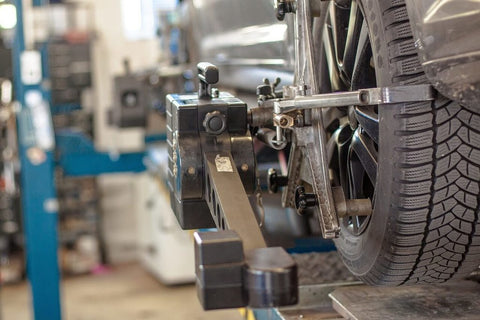
Purchasing a new car lift is an important decision. You need to understand what you hope to accomplish with the purchase before you can decide which car lift will best fit that purpose. This article will help explain the factors that go into deciding the right car lift to purchase.
Lift Purpose
Why are you thinking about purchasing a car lift? What are you hoping to accomplish?
Using a Lift for Storage
If you are considering purchasing a car lift for storage reasons, you should consider a 4 post car lift.
4 post car lifts allow for easy, drive up vehicle access. This means you can drive your car directly onto the lift, get out of your car, and lift it up for storage.
A 4 post lift is designed with a platform that gradually rises up into the air. This means your entire car is lifted up at the same time. Often these types of lifts allow you to park a 2nd car directly under the first car.
Additional Considerations include:
- You have the option of bolting a 4 post lift to the ground.
- Some 4 post lifts include casters which allow you to move the lift around the garage.
- 4 post lifts work with 110 volt wiring which is standard in most homes.
Can a 4 Post Car Lift Be Used for Repair Work?
Yes, a 4 post car lift can be used for car repair. However, you should not plan to be doing extensive car repair with a 4 post lift.
To do car repair on a 4 post lift, you need a supplemental jack to lift your car above the flat platform on a 4 post lift. An easy to accomplish this is with a rolling bridge jack, a sliding bridge jack, or a jack plate.
ProJack 35 Sliding Bridge Jack
The ProJack 35 offers 3,500 pounds of lifting capacity. This is a great supplement that works in combination with the following 4 post lifts:
- Garage Pro 7000
- Garage Pro 8000
- Garage Pro 9000
- Apex 8
- Apex 9
- 408SL
- 409HP
Repair Work with a Commercial Auto Lift
The commercial 4 post auto lifts include extra space on the inside edge to connect additional lifting accessories. Commercial grade rolling jacks can be rolled across the length of the platform. The rolling jacks will then raise and lower the vehicle using an air compressor.
The rolling jack allows you to raise and lower the vehicle a single axle at a time so you can take care of brake and tire work.
4 Post Lift Standard Model Features
People looking for a home lift that will mainly be used for storage and very limited repair work will most likely benefit from a standard 4 post model with a lift capacity that ranges from 7,000 pounds to 9,000 pounds.
Home users may also want to consider a drip tray which is used to protect cars parked on the ground level from liquids coming from a car parked above it on a 4 post lift.
Other options to consider include a caster or wheel kit for home garages. These accessories allow you to add some portability to a 4 post car lift that is not bolted to the ground. The caster wheels let you move the lift around your garage with ease.
4 Post Lift Premium Model Features
Premium 4 post lifts include a higher price point, but also provide some significant advantages compared with the standard models.
Premium models frequently offer a laddered safety system. This system will react every 4 inches. This type of system becomes a benefit especially on uneven floors.
Popular accessories for the premium 4 post lift models include rolling jacks and sliding jacks for doing repair work. Other popular accessories include long approach ramps for low profile cars and oil drains that are roll able along the platform.
- Check all 4 Post Car Lift options for sale.
Using a Lift for Repair Work
If you plan to use a car lift for extensive car repairs, you should consider a 2 post car lift. The key consideration is whether you are a professional mechanic or a home user than intends to do occasional repairs.
Professional vs Hobbyist
Professional mechanics have very different needs and requirements than home users that intend to store extra vehicles in their garage.
Professional mechanics planning to do extensive car repairs typically use a 2 post car lift. The reason for this is because mechanics require access to the undercarriage of the car. A 2 post lift lifts the vehicle from the center point and hoists it into the air.
Because there is only a single center bar, a 2 post car lift provides full access to the undercarriage for repair work.
2 post car lifts also include a few additional factors that make them more suited for a professional shop environment:
- 2 post car lifts are required to be bolted to the floor.
- Require 220 volt wiring. Most residential homes have 110 volt wiring.
- 2 post car lifts are not recommended for vehicle storage.
Compare a 2 post vs 4 post car lift.
Baseplate vs Overhead Lifts
2 post auto lifts are available in two designs: baseplate and overhead.
Baseplate Lifts
Baseplate models are designed with the hydraulic line connecting the two posts from the bottom of the unit. Baseplate lift units feature an open top design which doesn’t limit the height a car can be lifted.
The main consideration with baseplate designs relates to transmission work. Because the baseplate units include a 1 inch thick steel plate that runs across the floor, it can be difficult to roll equipment over this floor beam.
This can make rolling a transmission jack over the baseplate a bit of challenge. Businesses which do significant amount of transmission work might want to consider a two post overhead unit.
Overhead Lifts
Overhead lift models are designed with the hydraulic power line that connects the two posts at the top of the unit. These units include a steel beam that runs across the top of the unit. This provides some limitation on how high the vehicles can be lifted into the air.
The main benefit of an overhead lift is that it lacks the ground beam which can make it more difficult to work around.
The main consideration with an overhead lift is to make sure you have adequate lift height because of the limitation of the top steel bar. This becomes a consideration most often with taller trucks and commercial vehicles.
- Check all 2 Post Car Lift options for sale.
Home Users that Intend to Do Repair Work
This situation requires a little more time to really think through how you intend to use your car lift.
The short answer is that a 2 post car lift is best for regular repair work. These lifts offer easy access to the car undercarriage for repair work.
The main consideration is that 2 post lifts need to be bolted to the ground and they typically require 220 volt wiring. A residential home owner may not have 220 volt wiring without hiring an electrical contractor. A residential home owner also may not want to bolt a car lift into their home garage.
Scissor Lift
Scissor lifts is a good option to consider when you have more limited floorspace. If you are concerned about fitting a 2 post or 4 post lift in your garage or shop, you might want to think about a scissor lift.
Scissor lifts are available in low, mid, and full rise options. Scissor lifts are great for doing repair work in smaller sized spaces, but they are not intended for long term storage. So you shouldn’t look for a scissor lift to be a storage substitute for a 4 post lift.
Portable Scissor Lift
A portable scissor lift is another good option for home owners that want to do limited repair work, but don’t have the space to accommodate a 2 post car lift.
Portable scissor lifts have less lifting capacity than 2 post or 4 post car lift. They also don’t provide full access to the undercarriage like a 2 post car lift.
If you need to do frequent repair work, you will need to consider a scissor lift which has an open center design. Typically the portable scissor lifts do not include an open center, so you will need to consider a stationary scissor lift that offers an open floor design.
However, if you just need to be able to lift a car a modest amount in the air, a portable scissor lift is a good option to consider.
Alignment Lifts
Alignment Lifts are something that a professional shop might want to consider if you perform tire alignments on vehicles. Alignment lifts are specially designed lifts that include radius turn plates in the front and full floating slip plates in the rear. They offer a design that is fully integrated with the lift platform to allow wheel alignments to be completed.
Alignment lifts are available in 4 post or scissor lift models.
The Scissor Alignment Lifts require less space than 4 post alignment lifts. However alignment scissor lifts tend to be more expensive than the 4 post alignment lifts. The 4 post alignment lifts also have more options and are available in more sizes and capacities.
Lifting Capacity
Before you purchase a lift, make sure you understand the weight capacity you will need. Never exceed the listed weight capacity on a car lift. This can lead to serious injury.
Home users are less likely to require capacity for heavy duty trucks or commercial vehicles. Home garage users may want to consider 4 post lifts that range from 7,000 pounds of capacity to 9,000 pounds of lifting capacity.
If you are a professional user that needs higher lifting capacity, you may want to start with lifts ranging from 10,000 pounds to 16,000 pounds of lifting capacity.
Foundation Requirements
All car lifts require a flat and level concrete surface. You also need a concrete surface that is free of defects and cracks and has at least 4 inches of thickness.
You can read our full article explaining the required concrete thickness for a car lift.
Height Requirements
All car lifts require adequate space and ceiling height for efficient and safe operation.
4 post car lifts typically require the most ceiling height and scissor lifts require the least amount of ceiling height. Ceiling height requirements for 2 post car lifts fall in the middle between the scissor lift and the 4 post car lift.
- Read more about ceiling height for car lifts.
- Best Car Lift for 8ft Ceiling.
- Best Car Lift for 10ft Ceiling.
Space Requirements
2 post and 4 post car lifts typically require at least 12 feet of width and 24 feet of length. If you plan on lifting larger commercial vehicles, plan on extending the space length to match the types of vehicles in your shop.
- See 2 Post Car Lift Space Requirements for more information.
ALI Certification
The Automotive Lift Institute is the gold standard for car lift safety and quality. ALI has a rigorous testing program. If a car lift is ALI certified, it means that specific lift was thoroughly tested by an independent lab to confirm that it meets or exceeds required performance and safety thresholds.
If you have a professional shop, be sure to confirm whether your business location’s local ordinances require using lift equipment with ALI Certification.
- You can check the Automotive Lift Institute’s map to see if your location might require ALI certified equipment.
ALI certified equipment is typically more expensive, but you can be sure this equipment meets the highest quality standards in the market.
- Browse our selection of ALI Certified Lifts.
